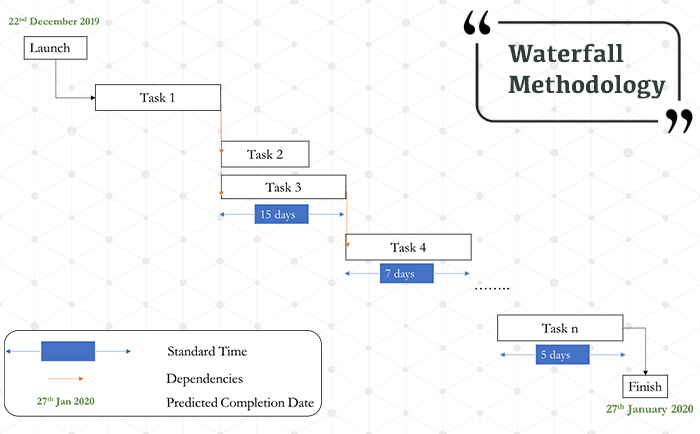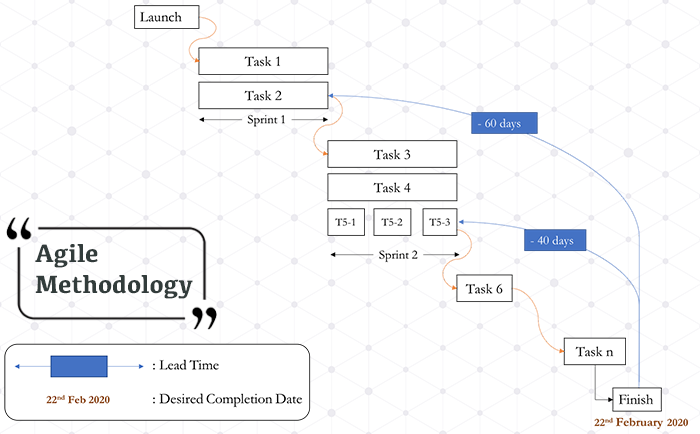In a report by Clearcode, 49% of managers who developed projects with the Adaptive methodology were challenged mid-project, while 57% of managers were challenged by following the Predictive methodology.
Post the dot com boom, agile (Adaptive) methodologies have seen many adopters compared to the conventional (Predictive) Waterfall methodology.
However, there is no single methodology that fits in every project, and in some cases, it may also require a blend of both for successful completion. Project managers should know how to strategize projects depending on the timeframe, budget, client’s requirements, and specifications. Continually working with a single strategy will improve the project managers’ and teams’ ability to implement the strategy efficiently and also improvise the whole development cycle. However, various project managers have reported that there is no one-size-fits-all solution in the world of project management.
Below we have explained the differences between Predictive (Waterfall) and Adaptive (Agile) project management and how to win projects in the long run.
Predictive Project Management
The predictive methodology focuses on planning and analyzing the projected future in-depth for anticipated risks. Also known as the Waterfall method, this methodology relies on an early phase analysis and a detailed breakup of features and tasks for the entire development process. In this traditional model, you define standard timelines to complete tasks and dependencies between tasks. This also determines the critical path and a projected completion date. It becomes quite challenging to change the direction of the project if something goes wrong. Predictive teams don’t appreciate change, and often buffers are added to timelines to begrudgingly accommodate minor changes.

The predictive planning strategy uses milestones to control the entire process. It is a very rigid model since the tasks get activated when previous tasks are completed, and there is very little wiggle room with respect to dynamic resource allocation and scheduling. The objective is to complete the project as fast as possible. If all goes well, with this methodology everything happens just in time, with optimal utilization of resources. The predictive planning fails when there is a significant project specification change or modification and leads to project paralysis.
The Predictive methodology is one of the best methods for projects that have regular standards and no scope of change. The predictive method doesn’t entertain flexibility in development and is ideal for projects that have been fully explored on the conceptual level and now only need to be implemented correctly with performance.
The predictive methodology is highly appropriate for:
The predictive methodology requires a sense of responsibility and an in-depth understanding of the project and technology. If somehow the project representatives are unable to educate the team project with exact information, the final product will not meet the requirements of the client and will lead to further changes, which can be time-consuming and incur more costs.
Adaptive Project Management
Also known as Agile methodology, adaptive project management caters to focusing on adapting quickly to changing scope and project reality. As with the waterfall model, with this methodology you still plan, schedule, identify key milestones and dependencies. But this model provides way more flexibility in the path to the end goal, which accommodates changing requirements along the way.

With this methodology, the team needs to have a different mindset, being open to working in shorter sprints and with short term goals. The development cycle is quite rapid and iterative. Adaptive teams are mission-focused and are clear about the work and tasks for the coming weeks, but not for the complete duration of the project.
In the Adaptive model, teams work backward from the desired completion date. Every task is defined along with its worst possible completion date and then clubbed with other tasks with similar timelines into sprints. Dependencies between every task will not necessarily be mapped out. This allows a more flexible model allowing for more wiggle room to adjust resources around and allows iterations due to innovation or scope change.
In this model, tasks may finish way ahead of time, and still the project completion date may stay put for other constraints. So the impetus here is more on quality and flexibility rather than speed.
The Agile methodology is popular for projects where clients’ demands and requirements change frequently. Though it may sound like a herculean task for the team, Agile is a faster approach compared to the Predictive project management strategy because of the flexibility of the timeline. By following an adaptive method, the final product may differ from the initial concept and make the overall journey more exploratory and innovative.
There are various steps in the agile technique, which generally include:
Which kind of teams and companies use agile:
In organizations with larger teams, they can also be broken into subgroups and follow the Adaptive methodology in cohorts.
There are various strengths and weaknesses regarding both the project management strategies, and it requires a clear understanding of the project requirement to adhere to a specific methodology. In some cases, a combination of methodologies with multiple milestones in the development journey are more suited. A stage-gate process is typically employed in many product development organizations, where a blend of both methodologies is efficiently deployed – a more agile approach during the ideation and validation phases, and a more structured approach in the execution and launch phases.
When selecting a tool to manage your projects, tasks, collaboration, and reporting, you need the flexibility to accommodate the varied methodologies you employ to manage your goals. The requirements may vary for each stakeholder in the organization. Unified user experience is of utmost importance to drive adoption.
For more details about the PMP training: https://www.itechgurus.org/pmp-project-management-professional-certification-training/
Source: Zovlv